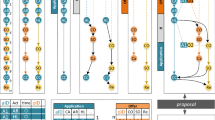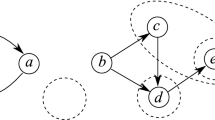Abstract
In order to use description logics (DLs) in an application, it is crucial to identify a DL that is sufficiently expressive to represent the relevant notions of the application domain, but for which reasoning is still decidable. Two means of expressivity required by many modern applications of DLs are concrete domains and general TBoxes. The former are used for defining concepts based on concrete qualities of their instances such as the weight, age, duration, and spatial extension. The purpose of the latter is to capture background knowledge by stating that the extension of a concept is included in the extension of another concept. Unfortunately, combining concrete domains with general TBoxes often leads to DLs for which reasoning is undecidable. In this paper, we identify a general property of concrete domains that is sufficient for proving decidability of DLs with both concrete domains and general TBoxes. We exhibit some useful concrete domains, most notably a spatial one based on the RCC-8 relations that have this property. Then, we present a tableau algorithm for reasoning in DLs equipped with concrete domains and general TBoxes.
Similar content being viewed by others
References
Allen, J.: Maintaining knowledge about temporal intervals. Commun. ACM 26(11), 832–843 (1983)
Baader, F., Hanschke, P.: A scheme for integrating concrete domains into concept languages. In: Proceedings of the 12th International Joint Conference on Artificial Intelligence, IJCAI-91, pp. 452–457. Sydney, Australia (1991)
Baader, F., Horrocks, I., Sattler, U.: Description logics as ontology languages for the semantic web. In: Hutter, D., Stephan, W. (eds.) Festschrift in Honor of Jörg Siekmann (2003a)
Baader, F., McGuiness, D.L., Nardi, D., Patel-Schneider, P.: The Description Logic Handbook: Theory, Implementation and Applications. Cambridge University Press, Cambridge, UK (2003b)
Balbiani, P., Condotta, J.-F.: Computational complexity of propositional linear temporal logics based on qualitative spatial or temporal reasoning. In: Frontiers of Combining Systems (FroCoS), pp. 162–176 (2002)
Bennett, B.: Modal logics for qualitative spatial reasoning. J. Interest Group in Pure and Applied Logic 4(1), 1–20 (1997)
Calvanese, D.: Reasoning with inclusion axioms in description logics: algorithms and complexity. In: Proceedings of the Twelfth European Conference on Artificial Intelligence (ECAI-96), pp. 303–307 (1996)
Calvanese, D., Lenzerini, M., Nardi, D.: Description logics for conceptual data modeling. In: Chomicki, J., Saake, G. (eds.) Logics for Databases and Information Systems, Chap. 8, pp. 229–263. Kluwer, Norwell, MA (1998)
Egenhofer, M.J., Franzosa, R.: Point-set topological spatial relations. Int. J. Geogr. Inf. Syst. 5(2), 161–174 (1991)
Frank, A.: Qualitative spatial reasoning: cardinal directions as an example. Int. J. Geogr. Inf. Syst. 10(3), 269–290 (1996)
Gabbay, D.M., Kurucz, A., Wolter, F., Zakharyaschev, M.: Many-dimensional Modal Logics: Theory and Applications, No. 148 in Studies in Logic and the Foundations of Mathematics. Elsevier, Amsterdam, The Netherlands (2003)
Haarslev, V., Möller, R.,: RACER system description. In: Goré, R., Leitsch, A., Nipkow, T. (eds.) Proceedings of the First International Joint Conference on Automated Reasoning (IJCAR’01), pp. 701–705 (2001)
Haarslev, V., Möller, R., Wessel, M.: The description logic \(\mathcal{ALCNH}_{R^+}\) extended with concrete domains: a practically motivated approach. In: Goré, R., Leitsch, A., Nipkow, T. (eds.) Proceedings of the First International Joint Conference on Automated Reasoning IJCAR’01, pp. 29–44 (2001)
Horrocks, I.: Using an expressive description logic: fact or fiction? In: Proceedings of the Sixth International Conference on the Principles of Knowledge Representation and Reasoning (KR98), pp. 636–647 (1998)
Horrocks, I., Patel-Schneider, P.F.: Optimising description logic subsumption. J. Log. Comput. 9(3), 267–293 (1999)
Horrocks, I., Sattler, U.: A description logic with transitive and inverse roles and role hierarchies. J. Log. Comput. 9(3) (1999)
Horrocks, I., Sattler, U.: Ontology reasoning in the \({\cal SHOQ}(D)\) description logic. In: Nebel, B. (ed.) Proceedings of the Seventeenth International Joint Conference on Artificial Intelligence (IJCAI’01), pp. 199–204 (2001)
Horrocks, I., Sattler, U., Tobies, S.: Practical reasoning for expressive description logics. In: Ganzinger, H., McAllester, D., Voronkov, A. (eds.) Proceedings of the 6th International Conference on Logic for Programming and Automated Reasoning (LPAR’99), pp. 161–180 (1999)
Lutz, C.: Complexity of terminological reasoning revisited. In: Ganzinger, H., McAllester, D., Voronkov, A. (eds.) Proceedings of the 6th International Conference on Logic for Programming and Automated Reasoning (LPAR’99), pp. 181–200 (1999)
Lutz, C.: Adding numbers to the \({\mathcal SHIQ}\) description logic—first results. In: Proceedings of the Eighth International Conference on Principles of Knowledge Representation and Reasoning (KR2002), pp. 191–202 (2002a)
Lutz, C.: PSpace reasoning with the description logic \(\mathcal{ALCF}(\mathcal{D})\). Log. J. IGPL 10(5), 535–568 (2002b)
Lutz, C.: Reasoning about entity relationship diagrams with complex attribute dependencies. In: Horrocks, I., Tessaris, S. (eds.) Proceedings of the International Workshop in Description Logics 2002 (DL2002), pp. 185–194 (2002c)
Lutz, C.: Description logics with concrete domains—a survey. In: Advances in Modal Logics Volume 4, pp. 265–296 (2003)
Lutz, C.: Combining interval-based temporal reasoning with general TBoxes. Artif. Intell. 152(2), 235–274 (2004a)
Lutz, C.: NExpTime-complete description logics with concrete domains. ACM Trans. Comput. Log. 5(4), 669–705 (2004b)
Lutz, C., Milicic, M.: A tableau algorithm for description logics with concrete domains and GCIs. In: Proceedings of the 14th International Conference on Automated Reasoning with Analytic Tableaux and Related Methods TABLEAUX 2005. Koblenz, Germany, pp. 201–216 (2005)
Lutz, C., Wolter, F.: Modal logics of topological relations. In: Proceedings of Advances in Modal Logics, 2004
Nebel, B., Bürckert, H.-J.: Reasoning about temporal relations: a maximal tractable subclass of Allen’s interval algebra. Journal of the ACM 42(1), 43–66 (1995)
Randell, D.A., Cui, Z., Cohn, A.G.: A spatial logic based on regions and connection. In: Nebel, B., Rich, C., Swartout, W. (eds.) Proceedings of the Third International Conference on Principles of Knowledge Representation and Reasoning (KR’92), pp. 165–176 (1992)
Renz, J., Nebel, B.: On the complexity of qualitative spatial reasoning: a maximal tractable fragment of the region connection calculus. Artif. Intell. 108(1–2), 69–123 (1999)
Russell, S.J., Norvig, P.: Artificial Intelligence: A Modern Approach. Prentice Hall, Upper Saddle River, NJ (1995)
Schmidt-Schauß, M., Smolka, G.: Attributive concept descriptions with complements. Artif. Intell. 48(1), 1–26 (1991)
Vilain, M., Kautz, H.: Constraint propagation algorithms for temporal reasoning. In: National Conference on Artificial Intelligence of the American Association for AI (AAAI 86), pp. 377–382 (1986)
Vilain, M., Kautz, H., van Beek, P.: Constraint propagation algorithms for temporal reasoning: a revised report. In: Readings in qualitative reasoning about physical systems. Morgan Kaufmann, San Francisco, CA, pp. 373–381 (1990)
Author information
Authors and Affiliations
Corresponding author
Rights and permissions
About this article
Cite this article
Lutz, C., Miličić, M. A Tableau Algorithm for Description Logics with Concrete Domains and General TBoxes. J Autom Reasoning 38, 227–259 (2007). https://doi.org/10.1007/s10817-006-9049-7
Accepted:
Published:
Issue Date:
DOI: https://doi.org/10.1007/s10817-006-9049-7




